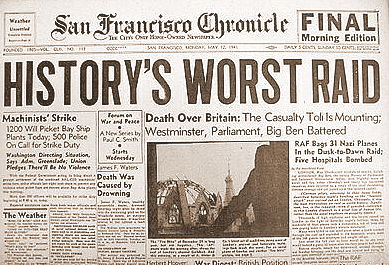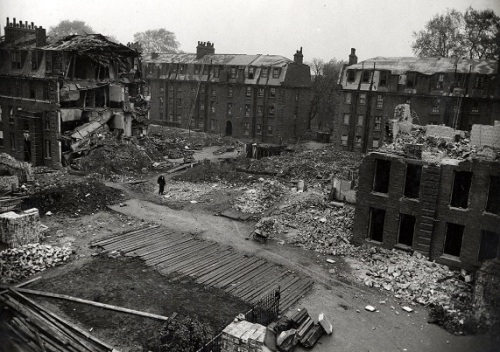On 11 May 1941, after eight months and five days of constant threat and terror, the nationwide Blitz came to an end.
Up to this point, approximately 41,000 tons of bombs had been dropped in total, with 18,291 tons falling on London alone. Around 41,000 people had been killed, 21,500 of whom were Londoners. 139,000 people had been injured and around two million homes destroyed, 60% of which were in London.

The Hardest Night
The night of 10/11 May became known as the ‘Hardest Night’ and was to be the last major raid on London for over a year; a major raid was defined as one where over 100 tons of bombs were dropped. It was to be one of the most ferocious and devastating of the entire nine-month German bombing campaign The raid on the city, carried out between 11.02pm and 5.57am, came a night illuminated by a full or ‘bombers’ moon, when the River Thames was at low-ebb tide. The low water level played havoc with the ability of firefighters to use water from the Thames to counter fires from incendiaries.
Statistics
During the seven-hour raid, more than 700 tonnes of high-explosive and 100,000 incendiary bombs were dropped by around 550 German aircraft. These undertook 571 sorties with some crews flying two and three missions in order to maintain numbers required to sustain the attack. Luftwaffe numbers were, by this time, depleted as many had been lost over Britain during the Blitz and other units had been moved east in preparation for the assault on Russia.

Fire
Of the high explosive dropped, 167 tons were recorded as unexploded the following day, along with 86,173 incendiaries. The London Fire Brigade reported 2,136 fires. Of these, nine were conflagration level, eight ‘major’ outbreaks (requiring 30-plus pumps), 43 serious outbreaks (up to 30 pumps), 280 medium (up to 10 pumps) and at least 1,796 small outbreaks. 1,436 Londoners were killed, with around 1,800 seriously injured. 700 acres of the city was destroyed – double the area lost in The Great Fire of 1666 – causing damage valued at £20 million in 1941.
Anti-aircraft guns fired 4,510 rounds with two bombers claimed destroyed. RAF Fighter Command dispatched a total of 325 aircraft and claimed 28 enemy aircraft in return, although one Hurricane and one Beaufighter were badly damaged. Surprisingly, the Luftwaffe lost only twelve aircraft that night: ten Heinkel He111s, one Junkers Ju88 and one Messerschmitt Bf110*.
*[This single aircraft crashed at Floors Farm, Bonnyton Moor, Glasgow at 11.05pm. It was flown from Augsburg by Deputy Führer Rudolf Hess on an mis-guided peace mission. Find out more about another Messerschmitt Bf110 that was displayed in Islington during the Blitz: The German Destroyer in Finsbury].
Islington and the Last Day of The Blitz
While enemy bombers concentrated on attacking the docks and East End, many other parts of the capital were to receive the full force of the Luftwaffe, including Islington and Finsbury. In Islington, the night found the rescue services once again fully extended, with the boroughs’ rescue services operating at several major incidents. Islington was hit by 38 high-explosive bombs, of which three did not explode, and 16 incendiary devices.

Archives]
On Saturday 10 May, 24 people were killed when bombs hit Corsica Street, Elia Street, Liverpool Road, Errol Street and Roman Way. An 18-month-old boy, Ronald Kenkerdine, was one of the six people killed at Liverpool Road, and three teenage sisters from the Smith family were among ten killed in Roman Way.
Sunday 11 May brought 62 further deaths. The victims came from Barbara Street, Charlotte Terrace, Essex Road, Gerrard Road, Halton Mansions, HMP Pentonville, Hanley Road, Holford Square, Old Street, Percy Circus and Whitecross Street. Ernest and Robert Westbrook, 11-year-old twin brothers, were two of the 18 people killed at Holford Square in King’s Cross and, nearby, three-month-old baby girl Mary Coyne was one of eight victims at Percy Circus.

Pentonville Prison
Of the nine major incidents covered that night by Islington’s rescue services, the bombing of HMP Pentonville Prison in Caledonian Road was one of the largest. C-Wing of the prison was hit by a string of high-explosive bombs that reduced the four-storey building to rubble, killing 13 people. It was closed after the bombing and didn’t reopen until 1946; the wing was eventually rebuilt to three storeys in 1958 becoming the prison’s education block.

Casualties
Total London casualties for the raid on 10/11 May were the highest for any night of the Blitz: 1,436 people died and 1792 were seriously injured. More than 5,000 houses were destroyed, making approximately 12,000 people homeless. Many famous and public buildings suffered damage, including the Houses of Parliament and the British Museum where 250,000 books were ruined.
Blitz Spirit
The capital, including Islington and Finsbury, would continue to suffer sporadic bombing raids and through the use of the V-weapons. Other cities and regions of England would also continue to suffer. The smaller ‘Baedeker Blitz’, which targeted historic/tourist locations, Exeter, Bath and Norwich and the Steinbock or ‘Baby Blitz’ affected southern England from January through to May 1944.
However, Hitler and the German Third Reich’s initial, great strategic bombing campaign to crush the British war industries and civilian morale was ultimately a failure. A combination of the Luftwaffe’s inability to agree on tactics, the British ‘Blitz Spirit’ reaction and the need for Hitler to divert resources for Operation Barbarossa against the Soviet Union brought the Blitz to a close.
Article written by Johnny Baird, Islington Museum volunteer
[All images Islington Local History Centre, except where stated]
Sources
- ‘The Blitz – The Hardest Night’, History of the Battle of Britain Online Exhibition, https://www.rafmuseum.org.uk
- The Blitz – Wikipedia, https://en.wikipedia.org/wiki/The_Blitz#Final_attacks
- islington.org.uk
- WW2 Civil Defence (1938-1945) Draft Transcript v1
- Islington & Finsbury WW2 incidents 10-11 May 1941
- Pentonville Prison, A, B, C and D Wings and Chapel Wing https://www.historicengland.org.uk
Further reading
- Blitzed Islington: Islington and the London Blitz (1940-41)
- The Blitz Period in Islington (1940-41) by W. Eric Adams (1946)
- Islington on the Home Front during the Second World War
- We’ll Meet Again: Islington on the Home Front in Photographs (1939-45) exhibition
- We’ll Meet Again: Islington on the Home Front in Photographs (1939-45) presentation
- Second World War Resources at Islington Local History Centre
Islington Local History Centre | Islington Museum
Islington Heritage Service
September 2020

Leave a comment